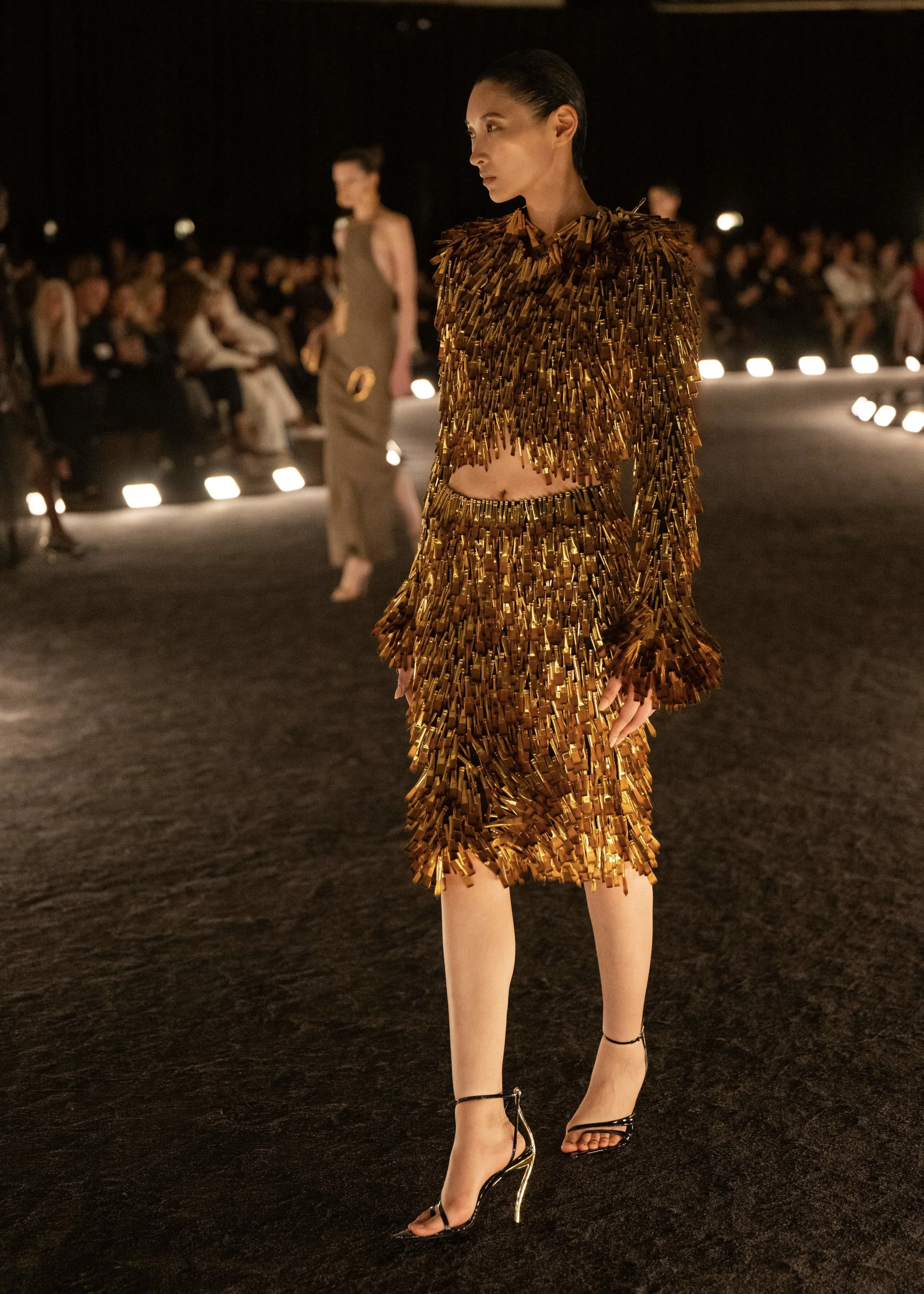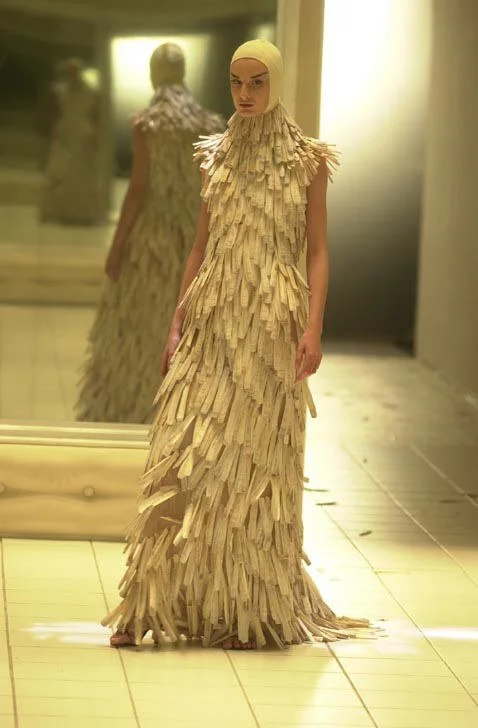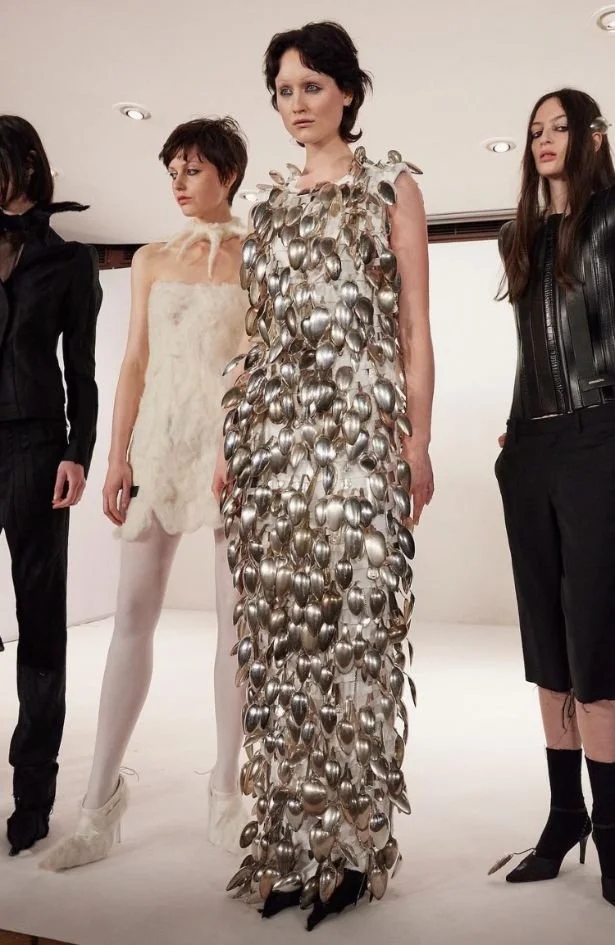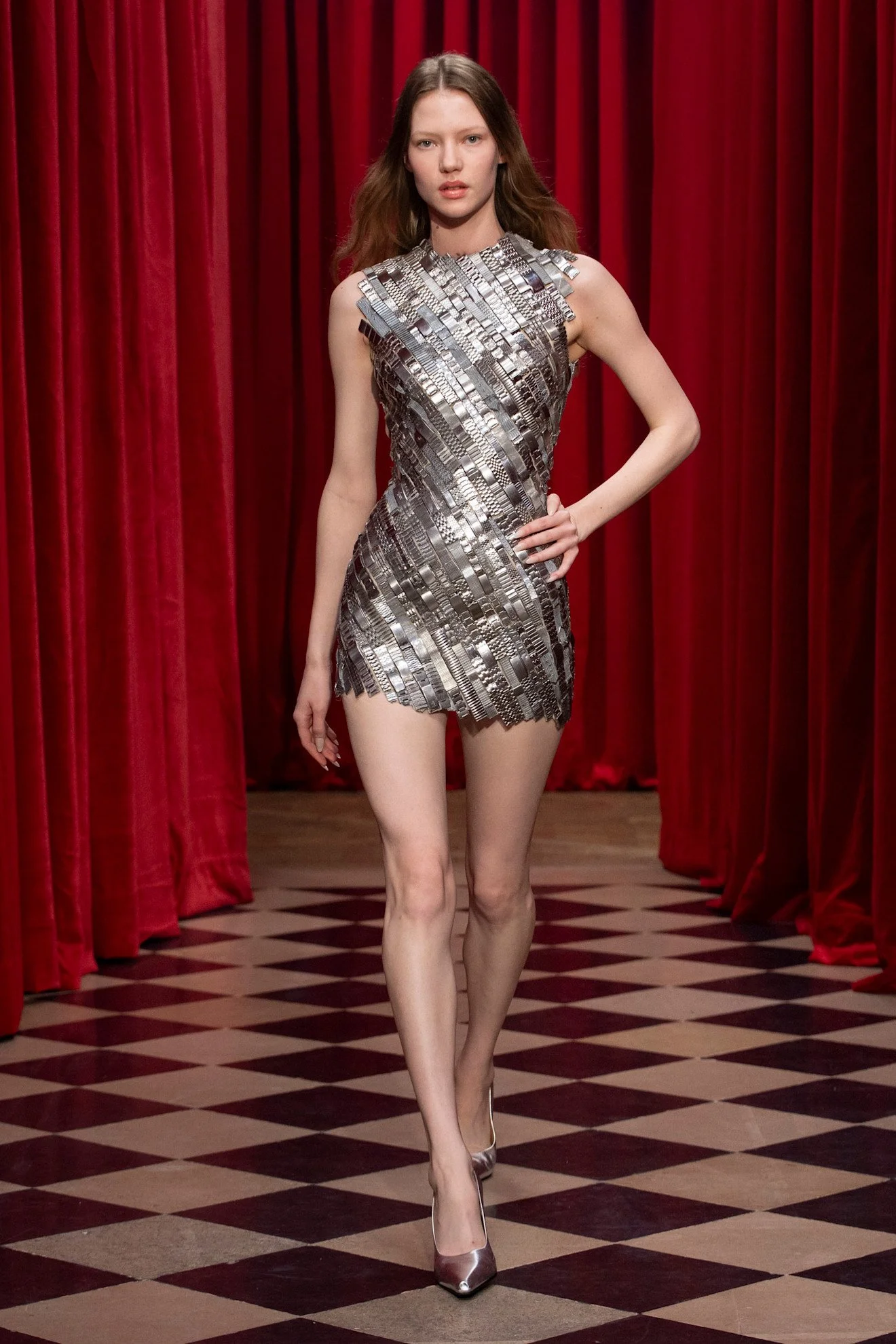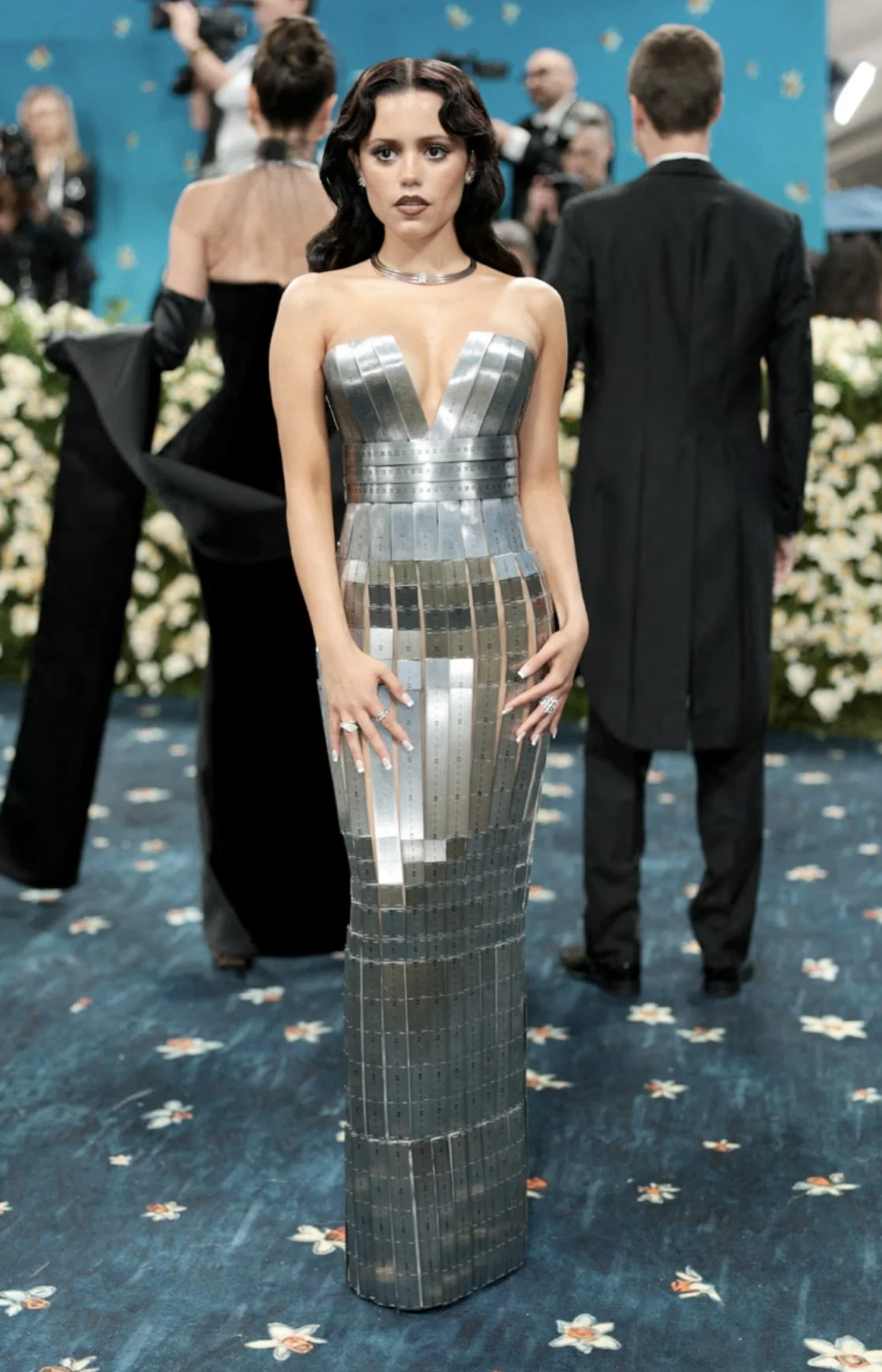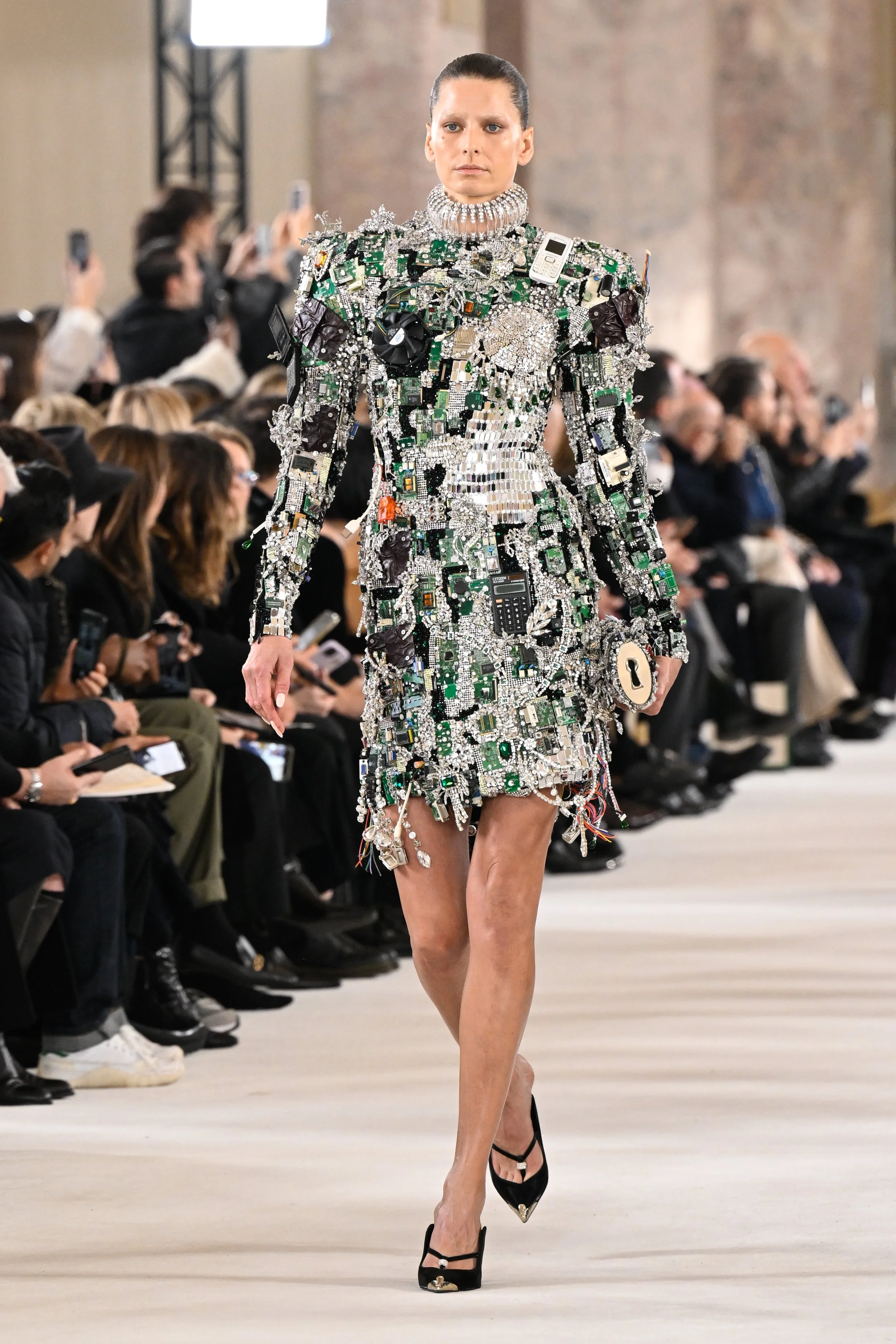Kitschy Couture: When Fashion Becomes Sculpture
Daniel Roseberry’s Look 38, ‘6000 Paint Brushes’ for Schiaparelli Spring Summer 2026
Kitschy Couture: When Fashion Becomes Sculpture
Haute couture has long been hailed as the pinnacle of fashion, craftsmanship and artistic vision. Often described as sculpture in fabric form, it gave us Charles James’s clover-inspired gowns and architectural silhouettes that could fold into a New York City yellow cab, or Mariano Fortuny’s pleated Delphos inspired dresses, recalling Grecian columns and fluid drapery. These garments, hand-stitched in Parisian ateliers and embroidered by the House of Lesage, were defined by precision tailoring, opulent fabrics, and jewel-toned dyes. Couture once signified femininity, excess, and status, a six to eight month process culminating in a one-of-a-kind gown, priced like a small fortune.
Yet, the contemporary couture landscape looks markedly different. While intricate detail and made to measure remain at the heart of haute couture, its language has expanded. The emphasis is no longer only on the delicate nature of lace and taffeta, but on conceptual rigor and pushing the boundaries of what couture can and should be. Today’s couture subverts the narrow ideals that once defined it, moving toward something more experimental, thought provoking and expansive. The readymade object now enters its vocabulary. The couture object becomes sculpture on the body, opening up to new ideas of reading fashion as living art forms.
In his seminal text The Fashion System (1967), Roland Barthes describes fashion as a “system of signification.” Clothing becomes a language in which each stitch, silhouette, and fabric choice carries symbolic weight. Today, this argument has shifted. Where once the finest silks and lace were a nod to wealth and status, now couture looks to the everyday object. A spoon, a watch strap, rulers, even a discarded computer chip, these have become couture’s new sequins, lace, and embroidery.
This impulse connects couture more closely to Marcel Duchamp’s Fountain or Jeff Koons’s Banality series than to the Battle of Versailles collections. Paco Rabanne’s razor dress of the 1960s and McQueen’s razor clam shells foreshadowed this logic, couture as object, as artifact, as critique. Now, that logic has returned with clarity, aligning couture with sculpture, parody, and irony.
Alexander McQueen’s Razor Clam Dress
The lineage of the readymade in haute couture begins with Alexander McQueen’s Razor Clam Dress from his Voss collection of 2001. Made from over 1,200 shells hand-sewn onto canvas, McQueen collected these shells from the beach, expressing that they had “lost their usefulness, so we put them to another use on a dress.” The Razor Clam Dress posed a question: when does a garment become an archive, an artifact, a sculpture? Does the unconventionality of material grant it a new lease to life, or a different kind of contextual weight?
Alexander McQueen (British, 1969–2010) © Sølve Sundsbø / Art + Commerce
On the runway, the body became both relic and spectacle. McQueen reanimated what was once a fragment, transforming it from object to ornament, inserting it into fashion’s lexicon as something at once provoking and unsettling.
Ellen Hodakova’s Spoon Dress
Swedish designer Ellen Hodakova Larsson emerged as a leading figure in readymade couture in 2024. Her practice is inspired by sculpture, as she notes: “Before I started fashion, I was studying sculpture, and I think that’s when I realised that I sculpt on the body.” Her floor-length gown of silver spoons is both humorous and subversive, transforming a domestic utensil, something that moves from hand to mouth, into decoration. The spoon’s normative context is reframed as embroidery, its function replaced by form.
Ellen Hodakova’s Spoon Dress, Fall 2023 collection
Embodying Walter Benjamin’s theory of aura, Hodakova’s spoons retain their history of use even as they glimmer under new meaning. Both satirical and ornamental, her couture collapses the boundary between the domestic and the spectacular, between sculpture and fashion. Through Hodakova, kitsch becomes critique, a language through which beauty is reconstructed rather than assumed.
Hailey Bieber, Jenna Ortega, and the Red-Carpet Readymade
The red carpet and brand events have become couture’s newest stage for experimentation and sculpture. Hailey Bieber’s upcycled Marine Serre mini dress, crafted from over 500 stainless-steel watch straps, shimmered like Paco Rabanne's razor dresses while nodding to fashion’s obsession with time. Taking an object that no longer fulfils its purpose, Serre recontextualises the watch strap as both embellishment and structure, blurring the boundaries between readymade and couture. The watch, once a tool of precision, becomes an ornament of transience.
Marine Serre, Fall 2025 Ready-to-Wear Collection, Look 43
Balmain, Metallic Dress for Jenna Ortega
Jenna Ortega’s Balmain gown, designed by Olivier Rousteing, worn at the recent MET gala is constructed entirely from rulers and tapes. This custom gown echoes the fluted forms of neoclassical columns and a bustier neckline. An ode to craftmanship, measurement and precision, the sheath dress became an embodiment of sculpture, spectacle and satire.
Together, these looks exemplify couture’s shift toward conceptual rigor. Neither dress functions: the rulers do not measure, the watches do not keep time. Instead, they destabilise the very mechanisms by which fashion defines itself, transforming the red carpet into an arena of irony, critique, and art.
Couture, once defined by exclusivity and excess, now flirts with themes of subversion and reuse. Kitsch becomes strategy, beauty redefined through the language of the readymade.
Daniel Roseberry’s Gadget and Paintbrush Dresses for Schiaparelli
At Schiaparelli, Daniel Roseberry has revived Elsa Schiaparelli’s surrealist spirit for the twenty-first century. Where Elsa collaborated with Salvador Dali to turn telephones into hats and lobsters into gowns, Roseberry draws on a new visual language, His Robot Dress, assembled from dismantled computer chips, and Swarovski crystals, sometimes incorporating a client’s own discarded devices, is part couture, part relic.
Daniel Roseberry’s Look 7, ‘Robot Dress’ for Schiaparelli Couture Spring 2024
Daniel Roseberry’s Look 38, ‘6000 Paint Brushes’ for Schiaparelli Spring Summer 2026
The same gesture animates his Paintbrush Dress, a cascade of more than six thousand gilded and lacquered brushes fitted to a sculpted bodice and skirt. Here, the tools of art become the medium of fashion, an uncanny inversion in which the instrument of making preliminary sketches becomes the object of display.
By translating the everyday object, the computer chip and the paintbrush into luxury, Roseberry continues Schiaparelli’s dialogue between fantasy and function, surrealism and satire. In both dresses, the readymade object is elevated to luxury. Here, objects of domestic use are reborn as symbols of imagination and experimentation.
Each of these garments speaks to fashion’s growing relationship with the readymade, the everyday and the kitsch. Contemporary couture is no longer designed merely to flatter the body but to question what a body can wear or withstand, or even express. The garment becomes symbolic and a concept. It is not merely clothing but an object, a philosophy worn on the body. Through the readymade, couture no longer merely adorns the body. It also interrogates and challenges it.
